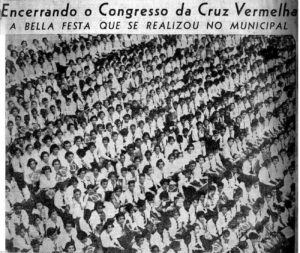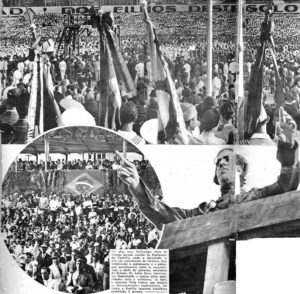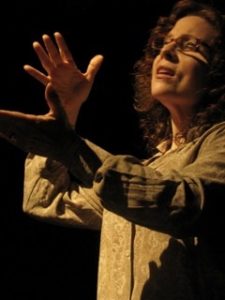Le Chant Choral au Brésil
Introduction
Comme l’a mentionné Carvalho[1] dans un précédent dossier sur le chant choral au Brésil, la taille du pays, le mélange des influences qui se sont rassemblées pour former la culture brésilienne (africaine, européenne et indigène) et la diversité des styles musicaux rendent difficile la tâche de rendre compte de la musique chorale dans sa globalité. Aussi cet article se concentre-t-il sur cinq aspects différents de la vie chorale au Brésil et explore certains des aspects qui lui sont propres, sous la plume de professeurs de musique, musicologues et chefs de chœur, qui abordent les aspects historiques de la musique au XXe siècle, le programme de l’éducation publique du pays, les chœurs de jeunes, l’arrangement choral et les chœurs d’entreprise. D’autres activités importantes comme les chœurs communautaires, les compositeurs et les festivals chorals ne seront pas abordés dans cet article par manque de place.
Le Chant Orphéonique[2] au Brésil avant Villa-Lobos
Flavio Silva
Les premiers essais pour rendre la pratique musicale systématique dans les écoles brésiliennes semblent avoir été faits par Barão de Macaúbas au cours de la deuxième moitié du XIXe siècle. Il a écrit en 1856 que « personne de nos jours ne doute des bienfaits de la musique qui améliore les comportements, rend les cœurs plus sensible, réveille les émotions et exalte les sentiments patriotiques ». En 1888, il a exprimé le désir que “la musique fasse partie des disciplines obligatoires dans les écoles élémentaires du pays.”
C’est à João Gomes Junior et à João Batista Julião que l’on doit les premières tentatives d’organisation d’une activité de chant collectif polyphonique, avec ou sans accompagnement instrumental, au début du XXe siècle à São Paulo. En 1921, les collectivités territoriales autorisent les Escolas Normais[3] à faire des “répétitions orphéoniques” (Fuks: 100). Fabiano Lozano a monter dans la ville de Piracicaba l’Orfeão Piracicabano, qui a réalisé plusieurs enregistrements et une tournée à Rio de Janeiro en 1925. A Pelotas, dans l’Etat du Rio Grande do Sul, Antonio Leal Sá Pereira a écrit une version à 4 voix de l’hymne national, qui a été chantée par le “Coro dos Mil” (le chœur des mille) dans le cadre des festivités pour la célébration du centenaire de l’indépendance du Brésil en 1922.
A Rio de Janeiro, la création d’un “Grande Coral Brasileiro” (Grand Chœur du Brésil) avait été suggérée en 1882, mais l’idée n’a apparemment pas été retenue. Le mois d’Octobre 1926 marque les débuts de la Sociedade Coral Brasileira, dirigée par Liuz Marisa Smido, Bento Mossusunga et Eduardo Souto. A ce propos, la Revista Musical avait déclaré : « il est étonnant qu’une institution de la sorte n’existe pas encore au Brésil ».
D’après Rosa Fuks, un comité composé de musiciens et d’enseignants brésiliens parmi lesquels l’on compte Francisco Braga, Sylvio Salema et Eulina de Nazateth avait été mis en place « dans le but de développer un programme musical [destiné] aux établissements scolaires de la capital brésilienne [Rio de Janeiro à l’époque] […] à travers le chant choral et la pratique instrumentale, de façon individuelle aussi bien que collective, un plan publié en 1930 » (Fuks : 114). Mais la bibliographie qu’elle cite ne se réfère pas aux textes publiés après mars 1930, dans les revues musicales Weco et Ilustração Musical par exemple, où Luciano Gallet ou même encore Lorenzo Fernandez critiquent le déclin de la vie musicale brésilienne en raison de la propagation de matériel de mauvaise qualité, ce dont ils rendent responsables la grande distribution de disques, les stations de radio et même les éditions de partitions. Le chant orphéonique dans les écoles avait alors été présenté comme une solution à ce problème. Ces articles ont eu un impact considérable à Rio de Janeiro et à São Paulo. En mars 1931, Lorenzo Fernandez a publié une étude détaillée intitulée « Le Chant Choral dans les Ecoles », basée sur le principe qu’ « il est nécessaire, avant tout autre chose, de former convenablement les professeurs des écoles ».
Pour l’instant il n’a pas été possible de trouver un lien entre le comité de 1929 mentionné ci-dessus et les critiques faites par Gallet et Fernandez, ou entre la publication du plan de 1930 (dont on n’a pas la date exacte) et l’article « Réagir » publié par Gallet au mois de mars de la même année.
L’arrivée de Villa-Lobos
Tout le monde sait que Villa-Lobos a participé à quelques concerts remarquables à Weimar et Barcelone au cours de sa deuxième tournée européenne. Il est aussi vraisemblable qu’il ait eu des liens avec le grand mouvement choral français[4], grâce à ses contacts avec le chef de chœur Robert Siohan. Il s’est rendu à São Paulo dès son retour au cours de l’été 1930. Des sources indiquent qu’il voulait réunir autant d’argent que possible afin de pouvoir revenir en Europe et y continuer sa carrière de créateur artistique ; « Il n’y a aucun indice dans les documents et les notes du compositeur qui indiquaient un désir de reprendre son rôle d’éducateur » (Guérios: 240).
On pense également que le compositeur aurait présenté un plan d’éducation musicale à Julio Prestes, alors président du pays (il a été destitué par un coup d’état monté par des révolutionnaires en octobre de la même année). Ce plan est probablement celui critiqué par le magazine Ilustração Musical en Février étant donné qu’il prévoyait « l’officialisation de la vie musicale nationale [… et …] l’interdiction de l’importation de musique étrangère [ou la demande] sa diminution d’au moins 50%. » Ce plan prévoyait également que « l’étude de la musique brésilienne soit complète, en commençant par l’harmonie; elle doit également inclure le rythme, la mélodie et le contrepoint, jusqu’à aborder le débat sur l’ethnicité et même les fondations philosophiques qui lui sont propres ». Mais le compositeur a abandonné ces idées moins de deux ans après avoir pris la tête du mouvement choral brésilien.
João Alberto, grand amateur de musique, Interventor[5] à São Paulo de Novembre 1930 à Juin 1931, a joué un rôle essentiel dans la décision de Villa-Lobos de prolonger son séjour au Brésil. Les informations à propos des débuts de leur relation sont contradictoires, mais on lui doit une série de concerts donnés par Villa-Lobos ainsi que d’autres musiciens dans plusieurs villes de la région de São Paulo entre Janvier et Avril 1931. Ensuite le compositeur a proposé à l’Interventor un grand spectacle musical civique, « l’Incitation Civique Villa-Lobos », qui a été présenté le mois de mai suivant et auquel ont participé environ 15 000 choristes et instrumentistes, en prélude aux grands rassemblements de chorales qui ont eu lieu à Rio de Janeiro après 1932.
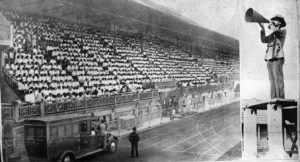
Villa-Lobos retourne à Rio dès la fin de l’année 1931. En Février 1932 est crée le « Serviço Técnico e Administrativo de Música e Canto Orfeônico » (Service Technique et Administratif pour la Musique et le Chant Orphéonique), et ce même mois est publié un document envoyé par le compositeur au Président Getúlio Vargas. Villa-Lobos y explique les difficultés rencontrées par l’activité musicale brésilienne. Quelques jours plus tard, Villa-Lobos est convié à présider le service. Il n’est pas impossible que ce soit João Alberto qui ait proposé le nom du compositeur pour ce poste. Mais il est certain que personne d’autre à l’époque n’aurait eu les compétences et le zèle nécessaires pour rassembler la bonne équipe en un temps aussi limité et, atteindre des résultats aussi impressionnants. Dès lors, Villa-Lobos n’a plus eu le désir de retourner à Paris et, pour la première fois, a cessé de dépendre des sponsors privés et des concerts pour gagner sa vie. Il était temps : la fin de l’année 1932 a marqué pour lui la fin de 45 ans d’errance.
Sources:
- Luiz Heitor Corrêa de Azevedo:Música e músicos do Brazil
- Rosa Fuks:O discurso do silêncio
- Paulo Renato Guérios:Heitor Villa-Lobos
- Recortes do periódicos no Museu Villa-Lobos
- Revistas Weco e Ilustração Musical
 Flavio Silva a étudié le piano (à Rio de Janeiro et Porto Alegre) et la Musicologie/l’Ethnomusicologie (Sorbonne, Paris), où il a écrit la dissertation « Origines de la samba urbaine à Rio de Janeiro ». Il est également titulaire d’un diplôme de Philosophie de l’Ecole Nationale de Philosophie de Rio de Janeiro. M. Silva est le Coordinateur pour la Musique Classique à FUNARTE, la Fondation Nationale d’Art du Brésil, où il supervise des activités allant de la préservation des archives musicales historiques à la célèbre « Bienais de Música Brazileira Contemporânea » (Biennale de Musique Brésilienne Contemporaine). Il a publié plusieurs articles et livres, dont « Camargo Guarnieri: o tempo e a música » et le catalogue du compositeur Francisco Mignone. Elu en 2008, M. Silvia occupe la Chaire n°28 à l’Academia Brazileira de Música (Académie Brésilienne de Musique). Il est père de deux enfants et marié à la pianiste renommée Laís de Souza Brazil, également membre de l’académie. Courriel: flazil@terra.com.br
Flavio Silva a étudié le piano (à Rio de Janeiro et Porto Alegre) et la Musicologie/l’Ethnomusicologie (Sorbonne, Paris), où il a écrit la dissertation « Origines de la samba urbaine à Rio de Janeiro ». Il est également titulaire d’un diplôme de Philosophie de l’Ecole Nationale de Philosophie de Rio de Janeiro. M. Silva est le Coordinateur pour la Musique Classique à FUNARTE, la Fondation Nationale d’Art du Brésil, où il supervise des activités allant de la préservation des archives musicales historiques à la célèbre « Bienais de Música Brazileira Contemporânea » (Biennale de Musique Brésilienne Contemporaine). Il a publié plusieurs articles et livres, dont « Camargo Guarnieri: o tempo e a música » et le catalogue du compositeur Francisco Mignone. Elu en 2008, M. Silvia occupe la Chaire n°28 à l’Academia Brazileira de Música (Académie Brésilienne de Musique). Il est père de deux enfants et marié à la pianiste renommée Laís de Souza Brazil, également membre de l’académie. Courriel: flazil@terra.com.br
La Recette d’Elza (ou « Les Commissions FUNARTE pour la Direction de Choeur »)
Samuel Kerr
Les Commissions Chorales ont été une solution « miracle », mise au point par Elza Lakschevitz alors qu’elle coordonnait le Projeto Villa-Lobos de Funarte[6]. En organisant cette série d’évènements dans les années 1980, la Fondation souhaitait soutenir les chœurs brésiliens. Et afin de prendre connaissance de leurs besoins, de leurs rêves et de leurs aspirations, Mme Lakschevitz avait invité des chanteurs et des chefs de chœur à une réunion qu’elle a appelé « les Commissions FUNARTE », une opportunité d’émettre des idées, un espace où partager son expérience musicale, un endroit pour la réflexion, où les problèmes qui intéressent la communauté chorale seraient discutés par les leaders musicaux brésiliens.
Ce fut un succès sensationnel. Les Commissions ont tenu dix sessions entre 1981 et 1993, stimulant le travail des chefs de chœur originaires de tous les états brésiliens, dans un effort qui a animé la musique chorale brésilienne pendant un long moment, même après la fin des réunions. Ce mouvement a été si considérable que le geste initial de Mme Lakschevitz, encouragé par le compositeur Edino Krieger et l’éducatrice musicale Valeria Peixoto, a été renouvelé en 2007 grâce à l’initiative d’Eduardo Lakschevitz et le soutien de l’éducatrice musicale Maria José Queiróz et du musicologue Flavio Silva, ce qui a ravivé la « recette » d’Elza, avec toute sa saveur.
Mais en quoi consistait cette recette?
C’est très simple. Réunir la tête de file des chorales du pays pour parler et discuter; puis demander quels problèmes doivent être abordés, le tout en s’échangeant des informations, en gardant ouvert de nouveaux espaces et en éloignant l’attention des grandes villes pour chercher à toucher le pays dans son ensemble. Sacré assaisonnement! Une rencontre annuelle devenue un évènement escompté et attendu avec impatience… un vrai régal.
Ceci se passait avant l’avènement d’Internet, et cette opportunité de se renseigner à propos des techniques de chant, du répertoire choral, des nouveaux arrangements, des procédés de répétition et des programmes était uniquement offerte aux réunions des Commissions. Dès que les réservations ouvraient, on s’arrachait très rapidement les places par téléphone, télégramme, télex et courrier (je rappelle qu’il n’y avait pas Internet).
La première session des Commissions a eu lieu à Rio de Janeiro en 1981, et la dernière de cette série à São Paulo, à l’USP[7], en 1993, après que des villes telles que Brasília, Nova Friburgo, Vitória, Cuiabá, Londrina et Goiâna les ont hébergées. Le succès d’une année déterminait la direction que pourrait éventuellement prendre le prochain; avec toutefois toute l’attention qu’Elza prenait à écouter ce que les participants avaient à dire et à suggérer. Entre les sessions des Commissions se tenaient de nombreux cours d’orchestration expérimentaux et de laboratoires de musique chorale, où toutes les idées étaient testées.
La recette était constamment réinventée, et Elza s’était assurée de ne pas en exclure certaines épices de la plus haute importance : des personnages éminents de la musique chorale brésilienne ont tenu des discours, donné des cours ou des masterclasses, ou simplement pris part aux réunions, assis côte-à-côte avec des chefs de chœur ou des chanteurs inconnus qui étaient alors fascinés par l’amitié offerte par des personnes qu’ils ne connaissaient que par leurs travaux et leur carrière, les livres qu’ils avaient écrit ou par les salles et les auditoriums portant leurs noms. On pouvait compter parmi eux Cleofe Person de Mattos, Nelson Mathias, José Vieira Brandão, Orlando Leite aussi bien que tant d’autres, dont la mention excèderait le cadre de cet article.
La recette incluait également des ingrédients existant spécialement pour l’occasion tels que Sargento (le sergent), Corão (le grand chœur ) et Corel (la corde à linge chorale).
À chaque session, un coordinateur était désigné pour faire le « sale travail » : essayer de tout faire dans les temps! Oh! Comme il était difficile de couper court aux discussions animées, d’interrompre un atelier des plus intéressants, ou de dire au chef du Grand Chœur qu’il/elle n’avait plus que cinq minutes de répétition! La tâche n’était pas simple pour ce coordinateur, qui était généralement perçu comme un personnage froid et inamical, et rapidement comparé à un sergent essayant de maintenir la discipline – Voilà le sergent qui vient encore nous couper dans notre élan!
Le Corão (Grand Chœur) était la grande assemblée des chorales. Tous les participants, chanteurs comme chefs de chœur, se retrouvaient sur les mêmes bancs sous la baguette d’un collègue, développant un répertoire destiné à être présenté à la fin de la session des Commissions. Si les œuvres chantées à chacune de ces occasions avaient été publiées, elles constitueraient aujourd’hui une grande anthologie. Elles étaient les premières de compostions et d’arrangements vocaux originaux écrits spécialement pour ou dédiés aux Commissions. Ainsi, des œuvres par ailleurs rarement présentées avaient là leur chance, car il était fascinant pour le chef de chœur d’avoir l’opportunité de travailler avec une chorale aussi grande et motivée, et surtout avec de telles compétences de déchiffrage! Chose encore plus utile, le travail du Grand Chœur était également assisté par un professeur de chant, Lúcia Passos, une des premières à l’époque à choisir le chant choral comme domaine d’expertise. Je me rappelle le soin qu’elle prenait à organiser la période d’échauffement, jusqu’au détail de la faire finir dans la clé utilisée pour la première chanson que le chef allait faire répéter. Je me rappelle aussi les solutions qu’elle trouvait au fil des répétitions pour les problèmes d’ordre vocal.
Beaucoup de sujets, certains difficiles voire douloureux, rencontrés par les chefs et leurs chorales étaient présentés lors de ces réunions, ou lors de conversations informelles. Ils allaient des contrats de travail à la durée des répétitions pour les chorales d’entreprises en passant par les difficultés de recrutement de voix masculines, des lois sur les droits de reproduction des représentations publiques aux enregistrements en passant par les partitions, à l’époque un thème nouveau au Brésil. Les problèmes de droits de reproduction apparaissaient alors à cause de la difficulté à convaincre les sociétés de production de distribuer les œuvres chorales, car il était inconcevable de devoir payer des droits d’auteur pour des chansons de MPB[8] arrangées et exécutées lors de concerts dont l’entrée était presque toujours gratuite. Ces sujets n’étaient en réalité pas nouveaux, mais seulement d’anciens problèmes nécessitant une nouvelle approche.
À cause de ces problèmes toujours non-résolus, l’ensemble des chefs souhaitaient toujours avoir une version des arrangements sous forme manuscrite, car il aurait été difficile de changer le répertoire sous une autre forme. Pour faciliter ce processus, le Corel a été instauré (une combinaison des mots « cordel », « coral » et « varal »[9]). Eh oui ! Plusieurs cordes à linge ont installées, on y accrochait des partitions mises là à disposition des chefs de chœur qui pouvaient alors demander des copies de celles qui les intéressaient ! Mais faut-il le rappeler seulement maintenant ? Je le pense. Plus que de pointer du doigt l’erreur de la reproduction, nous devons montrer la pertinence de cette pratique à cette époque précise. Les Commissions ont permis de faire connaître dans tout le pays les expériences chorales variées réalisées dans les différents états. Elles ont permis à la voix du Cordel d’être entendue partout. Une simple voix au sein du Cordel se retrouvait multipliée par des milliers d’autres chanteurs!
La recette d’Elza nécessitait également un préchauffage minutieux du four, et ce avant même de commencer à mélanger les ingrédients.
En effet, bien avant le début de chaque session des Commissions, elle invitait plusieurs chefs de chœur au siège de FUNARTE à Rio de Janeiro afin d’analyser le programme, de décider des ateliers, de lire les lettres et les formulaires d’évaluation des participants à la précédente session des Commissions. Elle demandait des idées de répertoires susceptibles de répondre aux attentes de chœurs originaires de tous les états et régions brésiliens. Je me revois prenant part à cette étape de consultation, en compagnie des chefs feu José Pedro Boéssio, Juan Serrano et Oscar Zander. Il est bon de pouvoir se les rappeler – sans oublier feu Marcos Leite. En 1985, le Grand Chœur a chanté un air qu’il avait créé pour les Commissions: Friburgo hosts choral music in the 5th. National Panel/Music, musicians/Magic, magicians/There is sound in the air…Alleluia! [Friburgo accueille la musique choral lors de la 5e commission/Musique, Musiciens/Magie, Magiciens/Il y a du son dans l’air…]

 Samuel Kerr a concentré sa carrière musicale sur le domaine de la musique vocale en tant que chef de chœur , arrangeur, organiste et professeur. Il a entre autres dirigé le Coral Paulistano do Teatro Municipal de São Paulo, les Chœurs de l’Université Publique de São Paulo (qu’il a fondés), le Cia Coral, l’association chorale Cantum Nobile, le Chœur des étudiants en médecine de l’hôpital Santa Casa, le Madrigal Psichopharmacom, et plusieurs autres ensembles. Il a également été directeur de l’École Municipale de Musique de São Paulo ainsi que le principal chef de l’Orchestre des Jeunes de São Paulo. Courriel: smkerr@terra.com.br
Samuel Kerr a concentré sa carrière musicale sur le domaine de la musique vocale en tant que chef de chœur , arrangeur, organiste et professeur. Il a entre autres dirigé le Coral Paulistano do Teatro Municipal de São Paulo, les Chœurs de l’Université Publique de São Paulo (qu’il a fondés), le Cia Coral, l’association chorale Cantum Nobile, le Chœur des étudiants en médecine de l’hôpital Santa Casa, le Madrigal Psichopharmacom, et plusieurs autres ensembles. Il a également été directeur de l’École Municipale de Musique de São Paulo ainsi que le principal chef de l’Orchestre des Jeunes de São Paulo. Courriel: smkerr@terra.com.br
Les Chœurs d’Entreprise
Eduardo Lakschevitz
Au Brésil, le monde de l’entreprise abrite une vie chorale active. Un grand nombre de sociétés, de tailles différentes, dans le public et dans le privé, parrainent des chorales auxquelles leurs salariés participent. Une telle activité est vécue comme un moment de relaxation dans une journée stressante de travail, dont bénéficient tant les employeurs que les salariés. Outre ce fait, les analystes en ressources humaines considèrent d’autres aspects présentés dans une chorale comme étant très semblables aux pratiques modernes de gouvernance corporative, des aspects tels que la l’interprétation d’un chœur comme un groupe de personnes travaillant ensemble pour accomplir un but commun. Les répétitions du chœur sont décrites comme des occasions où la hiérarchie habituelle de l’entreprise n’a plus cours (dans beaucoup d’entreprises, les chefs et les directeurs chantent côte à côte avec des ouvriers d’usine, visant à l’association parfaite de leurs voix), comme une expérience de travail en équipe et comme une activité qui exige en même temps la flexibilité de ses participants et une aptitude à faire attention aux objectifs de tous les membres de l’équipe. Les sociétés sont aussi motivées pour patronner des chœurs d’employés, afin de créer ou de renforcer une réputation d’être une institution qui travaille pour subvenir aux besoins sociaux de la communauté locale par des efforts de culture.
Petrobràs (Petróleo Brazileiro SA), l’un des plus grands conglomérats Brésilien, est l’un des premiers à avoir mis en place un chœur pour ses employés. Selon José Machado Neto, le coordinateur général du programme de chœur en entreprise, leur premier groupe a été établit dans une usine pétrolière en 1964. Aujourd’hui le Département de Communication Institutionnel de Petrobrás dirige 32 chorales réparties dans ses différentes usines à travers le pays. “Le chant choral est une partie solide de la culture d’entreprise, qui implique ouvriers tant actifs que retraités”, se plait à dire Machado Neto. “Notre festival choral bisannuel, où tous les groupes se réunissent dans un grand théâtre, est un événement prestigieux pour l’entreprise”.
Les chœurs d’entreprise brésiliens offrent un nombre significatifs de postes pour des chefs de chœur. Ces musiciens, cependant, font face à des situations tout à fait particulières. Souvent il n’y a pas assez de temps de répétition (mais c’est normal, nous autres chefs de chœur ne souhaitons nous pas tous toujours avoir plus de temps pour répéter?). Les pièces mises à la disposition de chœurs sont rarement idéales, et ils doivent souvent se les disputer lors des réunions d’affaires. Les chanteurs sont des volontaires et n’ont d’habitude pas d’audition à passer, un fait à prendre en considération puisque l’absence d’enseignement musical dans les écoles brésiliennes pendant des décennies fait du chœur d’entreprise la première expérience chorale pour beaucoup de participants. Aussi, puisque le chœur n’est pas l’activité principale de l’entreprise, il n’est pas rare que des chanteurs manquent les répétitions à cause de leur travail.
Comme les corporations contemporaines sont animées par la recherche de profit et de résultats, la plupart du temps ils attendent la même chose des chœurs qu’ils parrainent, le chef de chœur doit trouver comment faire pour que le groupe fonctionne musicalement, tout en faisant face aux aspects décrits ci-dessus. Faire preuve de souplesse peut de cette manière affecter les gestes de conduite (les chanteurs inexpérimentés ne sont généralement pas familiers des méthodes traditionnelles pour battre la mesure) et les techniques de répétition (ils n’ont aucune capacité pour le déchiffrage, il y a très peu de temps pour les répétitions et l’enseignement doit donc être très efficace). De plus, le style vocal des chanteurs est souvent semblable à celui qu’ils entendent régulièrement (habituellement celui des chansons populaires urbaines), encore très loin du style du Bel Canto. Bien que des procédures vocales saines soient constamment recherchées par les chefs lors des répétitions, la production de ce qui est habituellement considéré comme un son de choral occidental standard laisse place à un chant qui s’accorde mieux avec la culture contemporaine locale, dans laquelle les chansons populaires l’emportent largement sur le répertoire classique traditionnel.
Cette tendance peut aussi être observée dans le choix fait par les chefs de chœur, plus communément basé sur des arrangements de tubes populaires brésiliens. En effet, ces choix sont cruciaux pour le développement du chœur au sein de l’entreprise, car le groupe de volontaires ainsi que la participation des chanteurs dépendent fortement de la façon dont les membres se sont investis dans le projet, un processus dans lequel la connexion avec les chansons qu’ils chantent est capitale.
Le déséquilibre des voix (les chœurs comptent en général beaucoup plus de femmes que d’hommes) ainsi que le fait que les choristes ne soient pas auditionnés, demande une adaptation et un réarrangement constants des chants. Le chant A cappella est moins commun que l’utilisation d’accompagnement harmonique, joué surtout sur des claviers électroniques ou des guitares acoustiques, puisqu’il facilite l’enseignement et la mémorisation du répertoire. Les instrumentalistes de ces groupes sont souvent spécialistes de la musique populaire, étant donné que leur fonction demande aussi de la flexibilité musicale, une caractéristique qu’ils montrent d’habitude dans leurs concerts habituels. Les compétences d’un instrumentiste à gérer l’harmonie, la texture, la répétition sont bien plus importantes que sa capacité à déchiffrer. À l’époque où les chefs de chœur et de certains professeurs de musique considèrent les chorales d’entreprise comme une opportunité d’emploi, les compétences et les qualités requises pour ce travail ne sont pas abordées dans la préparation des diplômes de l’enseignement supérieur habituellement demandés pour diriger des chœurs. Par conséquent ces questions étaient très fréquemment discutées lors de récents cours et ateliers sur le thème de la direction de chœur à travers le pays.
Bien que quelques thèses et dissertations aient été consacrées aux chorales d’entreprise ces dernières années[10], on attend toujours une étude quantitative approfondie de ce type de musique chorale, un travail qui, quand il sera accompli, promet d’apporter beaucoup à l’art du chant choral.
 Dr. Eduardo Lakschevitz enseigne l’Histoire de la Musique à l’Université Fédérale de l’état de Rio de Janeiro (UNIRIO). Il a obtenu un Doctorat en Education Musicale dans la même institution et un Master en Direction de Chœur de l’Université de Missouri-Kansas-City (UMKC). Le Dr Lakschevitz est fréquemment invité à donner des cours au Brésil et aux États-Unis, il a récemment enseigné à l’Université Syracuse et au Westminster Choir College. Il a développé des programmes de formation professionnelle par la musique chorale dans la majeure partie des entreprises brésiliennes, dans des secteurs comme les services, la communication et l’enseignement. Il est également coordinateur pédagogique pour la musique chorale à FUNARTE (La Fondation Nationale pour les Arts). Ses compositions et arrangements sont publiés par la Alliance Musique et Colla-Voce. Courriel: edulx@me.com
Dr. Eduardo Lakschevitz enseigne l’Histoire de la Musique à l’Université Fédérale de l’état de Rio de Janeiro (UNIRIO). Il a obtenu un Doctorat en Education Musicale dans la même institution et un Master en Direction de Chœur de l’Université de Missouri-Kansas-City (UMKC). Le Dr Lakschevitz est fréquemment invité à donner des cours au Brésil et aux États-Unis, il a récemment enseigné à l’Université Syracuse et au Westminster Choir College. Il a développé des programmes de formation professionnelle par la musique chorale dans la majeure partie des entreprises brésiliennes, dans des secteurs comme les services, la communication et l’enseignement. Il est également coordinateur pédagogique pour la musique chorale à FUNARTE (La Fondation Nationale pour les Arts). Ses compositions et arrangements sont publiés par la Alliance Musique et Colla-Voce. Courriel: edulx@me.com
Les arrangements pour Chœurs de Musique Populaire Brésilienne
Eduardo Fernandes
L’adaptation des airs populaires joue, de nos jours, un rôle important dans le répertoire des chorales brésiliennes. Pourtant, ce rôle n’avait pas jusqu’à lors énormément retenu l’attention de la recherche universitaire. Mais aujourd’hui l’importance musicale et culturelle de ce travail d’adaptation, ainsi que les personnes qui ont écrit ce répertoire, commencent enfin êtres reconnues à leur juste valeur.
L’adaptation des airs populaires est une discipline à part, en ce sens qu’elle trouve son origine dans la culture de la production de masse (souvent assimilée à l’idée d’industrie culturelle), tout en utilisant à la fois un moyen classique d’expression (assimilé à une culture supérieure) à savoir l’ensemble choral. D’un côté, un tel mariage apporte à l’adaptation l’avantage d’être associée à deux importants visages de la culture contemporaine. Mais de ce fait, elle est condamnée à n’être reconnue par aucune de ces deux cultures.
Un brin d’histoire
La fin des années 1960 fut une période importante dans l’histoire de la production de musique populaire brésilienne. Le succès des festivals musicaux, dont la promotion a été assurée par plusieurs chaînes de télévision, et qui intéressaient une grande partie de la population, allant des classes moyennes jusqu’à des étudiants universitaires politiquement engagés, permit de rapprocher la culture de masse et la culture supérieure, celle-ci étant représentée par de jeunes compositeurs ayant étudié à l’université. En outre, la situation politique était délicate, le pays étant gouverné par une dictature militaire, et la question de l’établissement de valeurs sociales occupait alors une place importante dans les préoccupations de ces jeunes intellectuels.
Dans un environnement aussi instable, faire partie d’une chorale était un des seuls moyens pour ces jeunes de passer du temps ensemble et d’avoir le sentiment d’appartenir à un groupe. Cependant, le répertoire occidental traditionnel (représenté par la musique européenne tout comme par les arrangements folkloriques aux sonorités brésiliennes traditionnelles) s’est retrouvé à distance de la réalité urbaine et des attentes de la jeunesse de cette époque.
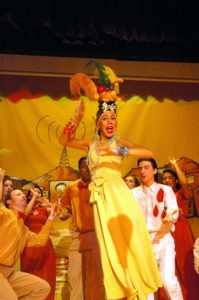
C’est alors que les arrangements de Damiano Cozzela ont commencé à être joués et promus de façon plus méthodique par Coralusp, le chœur de l’Université de São Paulo. L’augmentation des adaptations de musique populaire urbaine pour les chœurs, leur a ainsi permis de rapprocher l’expérience chorale de la vie quotidienne des jeunes, puisque les membres de ces chœurs commencèrent à chanter les mêmes chansons qu’ils écoutaient à la radio et à la télévision.
Néanmoins, cette intégration ne s’est pas faite pacifiquement. En effet, le monde de la musique classique critiqua fortement ce nouveau style de musique chorale, et les chefs de chœurs qui les dirigeaient. Ainsi, le chef de chœur Benito Juarez raconte que lors d’un concert de CORALUSP, qu’il dirigea au théâtre municipal de São Paulo (lieu de résidence de l’un des orchestres de la ville), et où il joua un répertoire varié (mélange de musique occidentale traditionnelle et d’arrangements de chansons populaires), une partie du public était habillé en noir, pour montrer qu’il « portait le deuil des concerts de musique de qualité ».
L’adoption de ce répertoire eut un impact plus vaste, qui allait au-delà de questions purement musicales et techniques. Les chorales se virent contraintes à réfléchir à un moyen de développer des spectacles plus représentatifs des chansons interprétées, ce qui a entrainé certains groupes à mettre en place une interprétation moins formelle et plus théâtrale de leur travail. Cette représentation fut l’embryon d’un style appelé par la suite coro cênico (chœur scénique[11]), initié par le chœur d’une école de médecine (Coral da Faculdade de Medicina da Santa Casa de São Paulo, dirigée par Samuel Kerr) et repris par le travail d’une chorale d’une école d’anglais à Rio de Janeiro (Coral da Cultura Inglesa, dirigée par Marcos Leite).

Le chœur, un espace de diversité
Sauf à l’exception de certains chœurs composés de membres partageant un profil particulier (l’âge, l’appartenante ethnique, la religion ou d’autres critères), la plupart des chorales amateures rassemblent des chanteurs de tous âges, et de tous milieux sociaux, culturels et économiques. Cela permet aux chorales d’avoir un large panel de références culturelles et esthétiques, qui transparaîtra immanquablement dans la façon de chanter du groupe, dans le choix du répertoire et dans la présence scénique. Ainsi, on peut non seulement affirmer que l’arrangement musical populaire porte en lui le caractère hybride mentionné ci-dessus, mais aussi que l’activité chorale amateur en tant que telle est submergée par ce caractère. La composition du chœur (ses chanteurs), les performances et la production finale reflètent bien ce fait.
La question de la voix
À répertoire spécifique, solutions spécifiques. Un chœur qui a l’habitude d’interpréter des chants d’opéra n’obtiendra pas forcément le même effet en chantant des airs populaires ou folkloriques, et ce en dépit des capacités techniques. Il est important de comprendre que chaque style de musique a des particularités qui lui sont propres. Aussi les techniques vocales utilisées devraient refléter la qualité de son attendue pour chaque style de musique différent.
Marcos Leite explique le problème concrètement :
Lorsque les étudiants cherchent à connaître les techniques de base, ils prennent souvent des leçons avec des chanteurs qui leur enseigneront le style lyrique. Cela est très bien, et ne pose pas de problèmes tant que la technique vocale ne se confond pas avec un but esthétique, qui s’exprimerait dans une manière de chanter appartenant à des répertoires différents. […] on peut déjà remarquer une grande incompréhension chez des chanteurs qui, n’étant pas sensibilisés à ce problème, chantent de la musique brésilienne tout en utilisant la sonorité du Bel Canto.[12]
On peut retrouver l’origine de cette confusion dans l’enseignement dispensé aux chefs de chœur (mais aussi aux coachs vocaux), qui reste majoritairement classique, et s’appuie sur la tradition européenne. Les rares livres sur la direction de chœur publiés au Brésil n’abordent pratiquement pas le sujet de la musique populaire urbaine dans le cadre d’une chorale. L’apparition des cours de premier cycle sur la musique populaire brésilienne est encore très récente, mais ils apportent la promesse d’être des médiateurs légitimes entre les deux traditions qu’aborde cet article. Que la plus grande partie des professeurs de culture vocale qui travaillent avec les choristes ont eux mêmes étudiés selon la tradition du Bel Canto constitue également un problème. Ainsi, un très grand nombre de chorales persistent à travailler sur une qualité de son qui n’a rien à voir avec la sonorité de base de la musique populaire brésilienne. Certains ouvrages publiés ces dernières années, comme ceux de Leite, Goulart et Cooper[13], trois musiciens très impliqués dans la musique populaire comme dans le domaine du classique, sont plus qu’appréciés, car ils commencent à combler le fossé entre les deux.
L’arrangement de la musique populaire brésilienne, une nouvelle opportunité
L’arrangement d’airs populaires pour les chœurs est une expérience esthétique riche pour les choristes. En effet, elle apporte non seulement des informations qui appartiennent déjà à leur vocabulaire (la chanson originale), mais elle ouvre également un nouvel horizon sur les possibilités offertes par le remaniement à voix multiples de cette chanson. Ces perspectives valent aussi pour le public, qui découvre ainsi de nouvelles manières d’écouter, de percevoir et de comprendre une chanson déjà connue.
Un bon arrangement peut avoir une structure aussi compliquée que celle de l’air original étant donné que les compositeurs/arrangeurs parviennent à utiliser plusieurs méthodes de composition, afin de donner de nouvelles perspectives à la chanson de départ. Qui plus est, la chanson populaire brésilienne est réputée pour être l’une des plus intéressante et des plus complexes au monde, autant pour sa musique que pour ses paroles. Ainsi, il est tout naturel et avantageux de l’utiliser comme source d’inspiration pour de nouvelles créations musicales.
 Eduardo Fernandes enseigne la direction de choeur à l’UNIFIAM/FIAMM et dirige le CORALUSP XI de Agosto, le Choeur UNIFESP et le Fine Arts University Center Choir. Il est titulaire d’un Master de Musique (de l’Université de São Paulo), a été récompensé pour un essai sur « l’arrangement vocal de la musique populaire à São Paulo et à Buenos Aires », et a également une Licence de basson (de l’Université de Campinas). M. Fernandes a été convié en tant que professeur invité à donner plusieurs cours à travers le Brésil, dont : Laboratório Coral de Itajubá, Fórum Rio a Cappella de Música Vocal et Panel FUNARTE de Música Coral. Ses principaux domaines de recherche sont concentrés sur les applications des sons et mouvements des percussions corporelles sur le chant choral. Courriel: dufer@terra.com.br
Eduardo Fernandes enseigne la direction de choeur à l’UNIFIAM/FIAMM et dirige le CORALUSP XI de Agosto, le Choeur UNIFESP et le Fine Arts University Center Choir. Il est titulaire d’un Master de Musique (de l’Université de São Paulo), a été récompensé pour un essai sur « l’arrangement vocal de la musique populaire à São Paulo et à Buenos Aires », et a également une Licence de basson (de l’Université de Campinas). M. Fernandes a été convié en tant que professeur invité à donner plusieurs cours à travers le Brésil, dont : Laboratório Coral de Itajubá, Fórum Rio a Cappella de Música Vocal et Panel FUNARTE de Música Coral. Ses principaux domaines de recherche sont concentrés sur les applications des sons et mouvements des percussions corporelles sur le chant choral. Courriel: dufer@terra.com.br
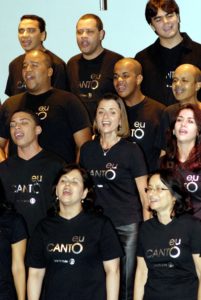
Les Choeurs de Jeunes au Brésil [14]
Patricia Costa
Bien que la musique chorale soit un instrument éducatif majeur pour toutes les tranches d’âge (en plus de son rôle efficace d’aide à l’éducation musicale), elle reste toujours une activité dénuée d’intérêt pour la plupart des adolescents brésiliens. Une étude récente fait remarquer qu’un préjugé se cache derrière le mot « chorale », ce que des auteurs, des chefs de chœur et même les jeunes chanteurs confirment.
Dans cette étude, le débat portait sur l’utilisation de la musique chorale comme outil éducatif, et l’idée d’inclure cette pratique musicale dans le programme des collèges. Cependant, les réponses suggèrent aussi très clairement le désir d’une approche plus spécifique dans la formation reçue par les chefs de chœur afin de leur permettre de comprendre de façon plus complète les problèmes que rencontrent les chœurs scolaires.
L’idée de s’adresser aux chefs de chœurs par le biais d’entretiens semi-structurés était une décision importante à prendre. Il s’agissait de commencer à combler le fossé causé par le manque de publications sur les activités chorales dans les collèges brésiliens. Aussi, ce travail a permis de développer la communication et l’échange d’expérience entre les chefs de chœurs de jeunes, un manque également mentionné par la majorité de ceux qui ont répondu au questionnaire.
A en juger par le faible nombre de réponses, il est clair qu’il n’y a pour l’instant que peu d’expertise dans ce domaine au Brésil. De même, il fut difficile pour les étudiants ayant pris part à ce projet de trouver des chefs de chœur travaillant spécifiquement avec des adolescents ; cela a mis en lumière le faible nombre de chorales qui s’adressent à cette tranche d’âge particulière, comme cela avait déjà été soulevé avant le début de l’étude.
En se servant de ces réponses, il a été possible de confirmer certains aspects que j’avais pu observer dans ma propre expérience en tant que professeur de chant, tels que :
- La formation de chef de chœur et celle d’éducateur sont étroitement liées, en atteste la certification de la majorité des chefs de chœur en éducation musicale.
- La référence pour les chefs de chœur de Rio de Janeiro est le Professeur Carlos Alberto Figueiredo.
- La plupart des chefs de chœur ne font généralement pas partie d’associations chorales ou de groupes similaires.
- De nombreux chefs de chœur participent à des stages et des ateliers au cours de l’année, ce qui montre un besoin de compléter et de mettre à jour leurs compétences acquises grâce au cursus scolaire classique.
- La musique chorale n’inspire pas toujours les collègues des chefs de chœur. Les réponses mentionnent souvent des préjugés, de la jalousie et même de l’indifférence à l’égard de cette dernière.
- Beaucoup de chefs de chœur mentionnent des problèmes dus à une défaillance vocale. Cependant, ceux-ci vont en général immédiatement chercher un traitement médical quand ils doivent faire face à cette situation.
- L’âge moyen dans les chœurs de jeunes sur lesquels a porté l’étude varie, ce qui prouve la difficulté d’établir un âge limite pour parler de chœur d’enfants ou de chœur de jeunes. Certaines réponses montraient également une confusion entre les concepts d’ « enfants » et d’« adolescents », qui avaient parfois l’air de référer à la même idée ; il faudrait alors parler de chœur « infanto-juvénile » [15], mais cette discussion dépasserait le but de l’étude.
- Les groupes au sein des églises mis à part, le taux d’abandon dans les chœurs de jeunes est élevé en comparaison à celui des autres tranches d’âge.
- L’assiduité des chanteurs aux répétitions est une preuve de leurs efforts et du plaisir qu’ils éprouvent à prendre part à cette activité.
- Les chefs de chœurs travaillant dans les collèges ont intérêt à prévoir leurs activités très soigneusement, en faisant attention aux périodes d’examen, aux vacances, aux jours fériés et aux autres aspects du calendrier scolaire.
- La musique populaire brésilienne est le répertoire adopté par la plupart des chœurs observés, les chanteurs étant généralement à l’origine du choix des morceaux.
- La plupart du temps ce sont les chefs de chœur eux-mêmes qui écrivent les arrangements pour ces morceaux, capacité qu’ils ont en général acquis par l’expérience ou grâce à des stages. Cela montre bien que soit le répertoire existant ne convient pas vraiment aux chœurs de jeunes, soit il y a un besoin urgent d’innovation dans la musique habituellement proposée à ces groupes.
- Les buts et les objectifs de ces chœurs effleurent souvent des aspects non musicaux, comme l’évangélisation, la promotion d’institutions sponsors, aussi bien que des aspects sociaux et pédagogiques (ces derniers étant les plus cités).
- La détermination d’une conception esthétique des groupes n’apparait pas comme un point important. En effet, la plupart des personnes interrogées n’ont pas d’opinion claire sur ce point. Certains la relient cependant à la qualité sonore du chœur. Grâce à ces personnes interrogées, il a été possible d’établir une dichotomie marquée entre le « chœur traditionnel » (interprétant un répertoire occidental traditionnel) et le « chœur populaire » (interprétant des arrangements de pièces populaires).
- Beaucoup de chefs de chœurs de jeunes font référence à des procédés de création collective, bien qu’ils soient très peu mentionnés par les chefs d’autres types de chœurs.
- Une grande partie des chefs de chœur adoptent, ou au moins songent à utiliser des outils scéniques pour leur travail.
- En ce qui concerne les réclamations à propos des activités des chœurs de jeunes, beaucoup de chefs de chœur ont les mêmes réponses : manque de moyens, manque de discipline et absentéisme élevé aux répétitions. Il a également été fait remarquer que beaucoup de chefs de chœur attendent de leurs élèves qu’ils se comportent comme des adultes, ce qui suggère encore une fois que leur formation devrait également inclure un volet pédagogique : comment s’occupe-t-on de cette tranche d’âge particulière ?.
- La plus grande satisfaction mentionnée par les chefs de chœur a une dimension non-musicale : c’est leur joie, leur énergie, leur volonté, leur vivacité et leur créativité dans leur travail, en parallèle à leurs nouvelles découvertes et aux connaissances acquises sur les transformations inhérentes à l’adolescence.
- La façon dont un chef de chœur voit un choriste adolescent a également apporté d’importantes réponses en ce qui concerne les aspects non-musicaux de l’enseignement déjà mentionnés ci-dessus. Parmi les progrès notés, on note le développement des capacités de travail en ateliers, l’amélioration de l’expression individuelle, une sensibilité accentuée, une capacité à lutter contre les préjugés et à faire face aux défis et de meilleurs perspectives d’avenir.
La grande majorité des chœurs de jeunes brésiliens adoptent un répertoire accompagné, pour la plupart au piano. Mais le fait que le chant a cappella se fasse si rare interfère avec le développement musical général de ces ensembles. En effet, un accompagnement instrumental harmonique permanent peut créer une attitude de dépendance du chanteur, ce qui lui rend plus difficile d’être dans le ton aussi bien individuellement qu’avec d’autres chanteurs.
Bien qu’appartenant “seulement” au domaine de la musique populaire, la production à grande échelle d’arrangements pour chœur des morceaux de ce répertoire contribue à faire revivre l’activité chorale, ce qui attire les adolescents ou tout du moins ne les repousse pas.
Les exercices scéniques et théâtraux ont été mentionnés comme des moyens utilisés pour faire participer au mieux les jeunes à l’activité chorale. Dans un moment de découverte individuelle, l’introduction d’exercices qui aident les jeunes à découvrir les possibilités d’expression qu’ils ont avec leur corps s’avère être une contribution solide à leur développement en tant que chanteurs.
Enfin, l’étude a analysé les éléments qui pourraient convenir au programme choral et, dans le même temps, éveiller l’intérêt de l’adolescent citadin pour le travail d’expression chorale. Il a été démontré que l’appareil scénique favorise également un rapport plus profond entre les chanteurs et l’interprétation du répertoire proposé, que ce soit par l’étude détaillée de la poésie de chaque pièce ou par l’environnement scénique créé, et même au moyen de la conscience physique comme l’aide à la perception plus précise des propositions musicales du groupe.
Chef de chœur, arrangeur et metteur en scène, Patricia Costa est titulaire d’un Diplôme en Education Musicale (1996) et d’un Master dans le même domaine (2009) de l’Université Fédérale de l’Etat de Rio de Janeiro (UNIRIO) pour ses recherches dans différents domaines dans la direction de chœur de jeunes. Auteur de plusieurs articles traitant du même sujet, Mme Costa a dirigé les programmes scolaires dans deux écoles : le Colégio Cruzeiro et São Vicente de Paulo, un chœur qui, sous sa direction, a gagné le premier prix au 2e Concours National Choral FUNARTE en 1999. Elle est fréquemment invitée à présenter des cours au Conservatoire Brésilien de Musique (Rio de Janeiro) et à l’Université Fédérale des Arts à Paraná. Courriel: pccantocoral@gmail.com
[1] Carvalho, Edson. Looking into the Future: Perspectives on Choral Life in Brazil. International Choral Bulletin, 2003/01.
[2] Le chant orphéonique est un mouvement né en France au début du XIXe siècle: il s’agissait alors de grandes chorales dont les membres étaient à l’origine issus des classes ouvrières. Le Brésil a repris le mouvement, en l’appliquant aux écoles, ce qui a souvent donné lieu à d’importants festivals où beaucoup de groupes de la sorte se rencontraient pour chanter en choeurs gigantesques.
[3] Etablissement chargé de former les professeurs.
[4] Voir la note n°2.
[5] Une sorte de gouverneur régionnal nommé par le gouvernement révolutionnaire.
[6] Fundação Nacional de Arte, une institution fédérale consacrée à la promotion des affaires artistiques et culturelles brésiliennes.
[7] L’université de São Paulo.
[8] MPB est l’acronyme de Música Popular Brazileira, un genre de musique populaire urbaine brésilienne majoritairement arrangée pour le chant choral.
[9] Cordel: style de littérature populaire, typique du nord-est du pays; Coral: chorale; Varal: corde à linge.
[10] Morelembaum, Eduardo. Coral de empresa: um valioso componente para o projeto de qualidade total. Dissertation. Conservatório Brazileiro de Música, 1999; Teixeira, Lúcia. Coros de empresa como desafio para a formação e a atuação de regentes corais: dois estudos de caso. Dissertation. Universidade Federal do Rio Grande do Sul, 2005; Rocha, Elen Regina Lara. Atuação do músico em empresas: mercado, indicativos e processos. Dissertation. Universidade Federal de Goiás, 2007; and Lakschevitz, Eduardo. A common chant: perceiving the company choir as an art world. Thesis. Universidade Federal do Estado do Rio de Janeiro, 2009.
[11] Ce sont des choeurs qui utilisent des mouvements de théatre pendant leurs représentations, à ne pas confondre avec l’idée d’un spectacle choral chorégraphié.
[12] LEITE, Marcos, “Método de Canto Popular Brazileiro”. Ed. Lumiar, Rio de Janeiro, 2001, p.4.
[13] GOULART, Diana. “Por todo canto”: coletânea de exercícios de técnica vocal /Diana Goulart , Malu Cooper. Rio de Janeiro, D. Goulart, 2000.
[14] Cette article est extrait de mon mémoire de Master, présenté en Juillet 2009 à l’UNIRIO (Université Fédérale de l’Etat de Rio de Janeiro), auquel ont été ajoutées des données sur des recherches en cours sur Internet qui détaillent les mêmes points.
[15] Des chorales qui réunissent enfants et adolescents.
Traduit de l’anglais par Mélanie Clériot, Marion Colange, Mathile Géhin et Calypso Lopez, France
